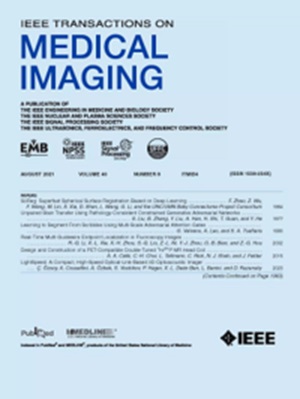A Laplacian Pyramid Based Generative H&E Stain Augmentation Network
IF 8.9
1区 医学
Q1 COMPUTER SCIENCE, INTERDISCIPLINARY APPLICATIONS
引用次数: 1
Abstract
Hematoxylin and Eosin (H&E) staining is a widely used sample preparation procedure for enhancing the saturation of tissue sections and the contrast between nuclei and cytoplasm in histology images for medical diagnostics. However, various factors, such as the differences in the reagents used, result in high variability in the colors of the stains actually recorded. This variability poses a challenge in achieving generalization for machine-learning based computer-aided diagnostic tools. To desensitize the learned models to stain variations, we propose the Generative Stain Augmentation Network (G-SAN) - a GAN-based framework that augments a collection of cell images with simulated yet realistic stain variations. At its core, G-SAN uses a novel and highly computationally efficient Laplacian Pyramid (LP) based generator architecture, that is capable of disentangling stain from cell morphology. Through the task of patch classification and nucleus segmentation, we show that using G-SAN-augmented training data provides on average 15.7% improvement in F1 score and 7.3% improvement in panoptic quality, respectively. Our code is available at https://github.com/lifangda01/GSAN-Demo.基于拉普拉斯金字塔的生成H&E染色增强网络
苏木精和伊红(H&E)染色是一种广泛使用的样品制备方法,用于增强组织切片的饱和度以及医学诊断组织学图像中细胞核和细胞质的对比。然而,各种因素,如所用试剂的差异,导致实际记录的污渍颜色变化很大。这种可变性对实现基于机器学习的计算机辅助诊断工具的泛化提出了挑战。为了使学习到的模型对染色变化不敏感,我们提出了生成染色增强网络(G-SAN)——一种基于gan的框架,通过模拟但现实的染色变化来增强细胞图像集合。在其核心,G-SAN使用了一种新颖的、计算效率很高的基于拉普拉斯金字塔(LP)的生成器架构,能够从细胞形态中分离出染色。通过斑块分类和核分割任务,我们发现使用g - san增强的训练数据,F1得分平均提高15.7%,全视质量平均提高7.3%。我们的代码可在https://github.com/lifangda01/GSAN-Demo上获得。
本文章由计算机程序翻译,如有差异,请以英文原文为准。
求助全文
约1分钟内获得全文
求助全文
来源期刊

IEEE Transactions on Medical Imaging
医学-成像科学与照相技术
CiteScore
21.80
自引率
5.70%
发文量
637
审稿时长
5.6 months
期刊介绍:
The IEEE Transactions on Medical Imaging (T-MI) is a journal that welcomes the submission of manuscripts focusing on various aspects of medical imaging. The journal encourages the exploration of body structure, morphology, and function through different imaging techniques, including ultrasound, X-rays, magnetic resonance, radionuclides, microwaves, and optical methods. It also promotes contributions related to cell and molecular imaging, as well as all forms of microscopy.
T-MI publishes original research papers that cover a wide range of topics, including but not limited to novel acquisition techniques, medical image processing and analysis, visualization and performance, pattern recognition, machine learning, and other related methods. The journal particularly encourages highly technical studies that offer new perspectives. By emphasizing the unification of medicine, biology, and imaging, T-MI seeks to bridge the gap between instrumentation, hardware, software, mathematics, physics, biology, and medicine by introducing new analysis methods.
While the journal welcomes strong application papers that describe novel methods, it directs papers that focus solely on important applications using medically adopted or well-established methods without significant innovation in methodology to other journals. T-MI is indexed in Pubmed® and Medline®, which are products of the United States National Library of Medicine.
 求助内容:
求助内容: 应助结果提醒方式:
应助结果提醒方式:


